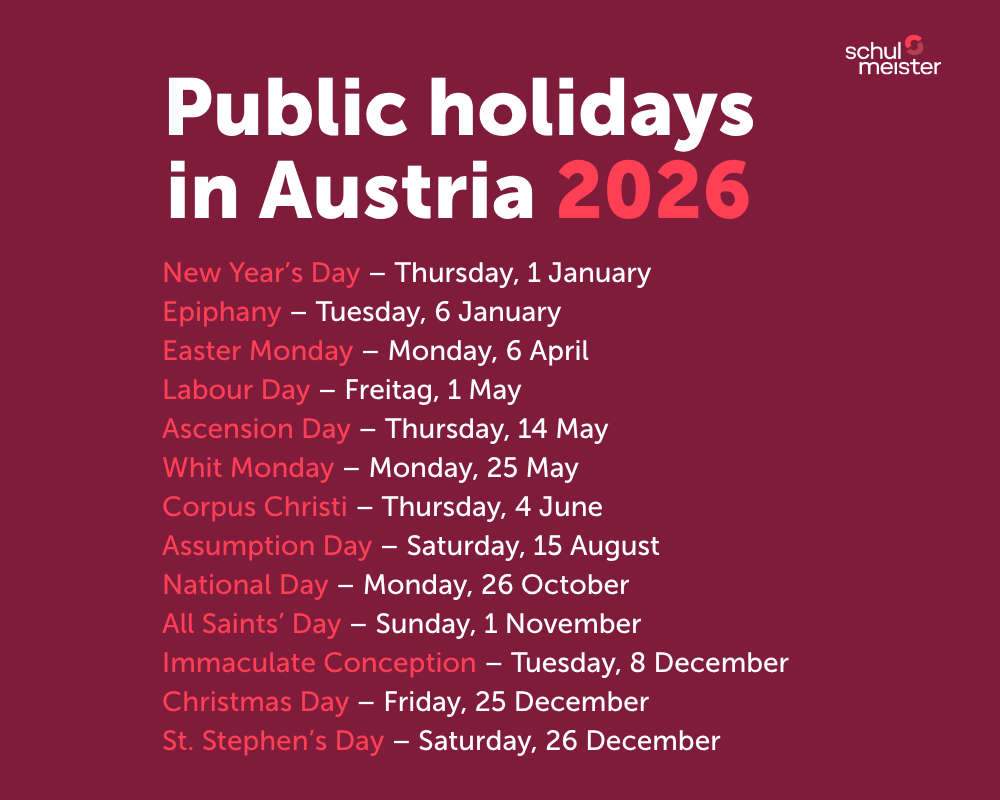Quick answer: Austria has thirteen public holidays in 2026, many of which fall conveniently on Mondays or Thursdays. With careful holiday planning and the use of long weekends, employees can significantly extend their time off – up to 50 days off per year are possible.
Why are there so many public holidays in Austria?
Public holidays are more than just welcome breaks from everyday life. They usually have cultural, historical and social significance. Many Austrian public holidays have religious origins and reflect the country's long tradition, while others commemorate important national events such as the National Holiday. With a total of thirteen public holidays, Austria is one of the frontrunners in the EU. Only a few countries, such as Spain and Luxembourg, have a similar number of public holidays. For employees, this means more opportunities to relax and recharge their batteries.
All public holidays in Austria in 2026 at a glance
Before you enter your holiday dates, it is worth taking a look at the public holidays for the upcoming year. Austria has thirteen public holidays, which can vary depending on the federal state. Many dates fall conveniently on a Monday or Thursday, opening up perfect opportunities for long weekends. The graphic on the right provides an overview of all nationwide public holidays.
Vacation planning for 2026: the best long weekends and holiday combinations
If you plan your 25 vacation days for 2026 wisely, you can use them twice as effectively. Some public holidays are particularly well placed and can be combined with a few long weekends to create long periods of relaxation. Here is an overview of the best periods:
January to March
- New Year's Day (Thursday, 1 January) & Epiphany (Tuesday, 6 January) – Take Friday and Monday off and enjoy four consecutive days of relaxation right at the start of the year. → 1–6 January off = 6 days of relaxation with 2 vacation days.
April to June
- Easter Monday (6 April) – Ideal for a short spring break. If you also take Tuesday to Friday off, you can enjoy nine consecutive days off. → 4–12 April off = 9 days of relaxation with 4 vacation days.
- Labour Day (Friday, 1 May) – Combine it with a vacation day on Monday and extend the weekend to four days. → 1–4 May off = 4 days of relaxation with 1 vacation day.
- Ascension Day (Thursday, 14 May) – The classic long weekend: take Friday off and enjoy four days in a row. → 14–17 May off = 4 days of relaxation with 1 vacation day
- Whit Monday (25 May) – With an additional day off on Friday, you can extend the weekend to four days. → 22–25 May off = 4 days of relaxation with 1 vacation day.
- Corpus Christi (Thursday, 4 June) – Once again an opportunity for a long weekend – ideal for an early summer break. → 4–7 June off = 4 days of relaxation with 1 vacation day.
July to September
There are no national holidays on weekdays during these months. The 15th of August falls on a Saturday in 2026. Summer is therefore the ideal time to plan your main holiday.
October to December
- National holiday (Monday, 26 October) – A free long weekend. If you also take the Friday before off, you can enjoy four days with just one day of holiday. → 23–26 October off = 4 days of relaxation with 1 vacation day.
- All Saints' Day (Sunday, 1 November) – Falls on a Sunday in 2026, but remains an official holiday.
- Immaculate Conception (Tuesday, 8 December) – Take Monday off and enjoy four days off – perfect for taking a breather in the run-up to Christmas. → 5–8 December off = 4 days of relaxation with 1 vacation day.
- Christmas Day (Friday, 25 December) & St Stephen's Day (Saturday, 26 December) – 24 December is regulated differently depending on the collective agreement: in many companies, it is considered a half working day or is given off completely, while in others, it counts as a normal working day. Take a longer break between Christmas and New Year at the end of the year. → 24 or 25 December to 3 January (2027) = 10 days of rest with 4 vacation days.
💡 Tip: If you strategically distribute your 25 vacation days around these public holidays, you can have over 50 days off in 2026.
YOU CAN DOWNLOAD OUR PUBLIC HOLIDAY CALENDAR AND VACATION PLANNING GUIDE FOR 20206 HERE
Tips for planning your holidays in 2026
Good timing is everything – and that also applies to holiday planning. Plan ahead so that you can make the most of your days off and avoid unnecessary stress.
Communication: Especially around public holidays, many companies are extremely busy coordinating vacation days. Request your days off as early as possible to secure the best periods. This also ensures that projects and substitutions can be coordinated accordingly. Early planning often means more choice and fewer compromises.
Team coordination: Good coordination is crucial, especially in smaller teams or when working on projects. Coordinate your holiday times with colleagues so that important tasks continue to run smoothly and no one is overloaded. Transparent planning ensures better cooperation – and often more understanding when others want to take vacation days later on.
Timing & annual cycle: In almost every profession, the course of the year brings phases of varying intensity. After particularly busy weeks or projects, there are usually quieter periods that are perfect for taking time off. Use these periods specifically to recharge your batteries, gain some distance and start the next challenge with a clear head. Conscious planning ensures that your relaxation fits into your everyday life – without losing sight of important appointments or deadlines.
Extra tip: As tempting as it may sound to plan all your holidays at the beginning of the year, save a few days as a buffer. Spontaneous opportunities for short breaks, long weekends or private appointments that were not on your radar before often arise during the course of the year. Stay flexible by keeping a few vacation days in reserve.
Conclusion: Maximum relaxation with minimum use of vacation days
Public holidays are much more than mere interruptions in the working year – they remind us of traditions, history and shared values. At the same time, they are valuable fixed points for relaxation. Especially in a working day that is often characterised by speed and deadlines, short breaks help to recharge your batteries and maintain your performance in the long term.
Those who plan their days off wisely benefit even more: with strategic holiday planning, even in 2026, it will be possible to take many longer breaks with just a few vacation days. This creates small oases of relaxation in the calendar – without having to use up the entire annual holiday allowance. Those who plan ahead remain flexible, relaxed and start each new phase of work with greater composure.





